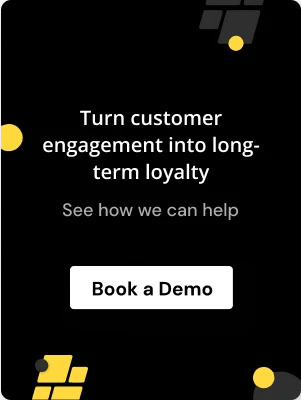.avif)
.avif)
Why do some customers keep coming back, while others drop off after their first purchase? It’s not always about discounts. Or flashy ads. In a market flooded with options, what sets truly loyal customers apart is how valued they feel, not just how much they spend. And this is where many D2C brands miss the mark.
The truth is, if you’re still relying on generic rewards or one-size-fits-all perks, you’re leaving serious revenue on the table. Today’s customers expect more than just points for purchases; they want experiences, exclusivity, and recognition. That’s where VIP tier programs come in.
Studies show that the loyalty market in the United States is expected to grow by 15.7% on an annual basis to reach US$27.26 billion in 2025.
Designed right, a tiered loyalty model doesn’t just reward repeat purchases, it builds a sense of belonging, fuels long-term retention, and creates a powerful reason for customers to stay engaged with your brand. And the best part? You don’t need a massive tech stack to get started.
In this blog, we’ll walk you through what a smart tiered offer system looks like, how it drives performance across Shopify and WooCommerce stores, and why top-performing D2C brands are making VIP tiers a core part of their retention strategy. Let’s break it down.
TL;DR
- VIP tier programs elevate customer loyalty beyond simple points: they deliver exclusivity, recognition, and experiences.
- Brands using tiered systems see higher repeat purchases, retention, order value, and referrals.
- Start simple: three tiers, clear perks, and make advancement visible and achievable.
- Avoid loyalty pitfalls: boring rewards, complexity, and lack of communication.
- Measure success by tracking repeat purchase rates, LTV per tier, engagement, and advocacy.
- No need for coders: modern no-code tools make launching and managing VIP programs quick and easy.
What Is a Tiered Loyalty Program and Why It Works
Let’s be honest, most loyalty programs feel a little forgettable. Points pile up, rewards trickle in, and customers barely notice. But tiered loyalty programs? They flip that script completely.
Instead of offering the same reward to everyone, a tiered program gives customers something to work toward. The more they engage, whether spending, referring, or interacting with your brand, the higher they climb. And with each level comes better perks, more recognition, and that sweet sense of exclusivity.
It’s less “buy and get a coupon,” more “become part of something.”
Think of it like this: Would you rather collect generic points or earn Gold status that unlocks early access, birthday surprises, and VIP treatment? When done right, tiered programs tap into something deeper than discounts; they make customers feel seen.
Also read: Effective Tiered Reward Levels and Benefits Guide
Why Tiers Outperform Traditional Points-Based Systems

Flat loyalty programs tend to treat everyone the same. But that’s not how customer behavior works. Some people are superfans. Others are just getting to know you. A tiered model meets each one where they are and nudges them upward.
There’s actual science behind this. It’s called the goal-gradient effect. People are more likely to take action when they can see progress. The closer they get to the next tier, the more motivated they are to keep going.
And the payoff? Brands using tiered programs consistently report:
- Higher repeat purchase rates
- Bigger average order values
- More referrals (especially from top-tier customers)
- Better retention, not just at the top, but across all levels
So no, it’s not just about handing out free stuff. It’s about creating momentum, something flat programs rarely manage to do.
So, how do you design a program that doesn’t just exist, but actually drives retention, boosts lifetime value, and keeps people coming back?
How to Set Up a Tiered Loyalty Program That Works
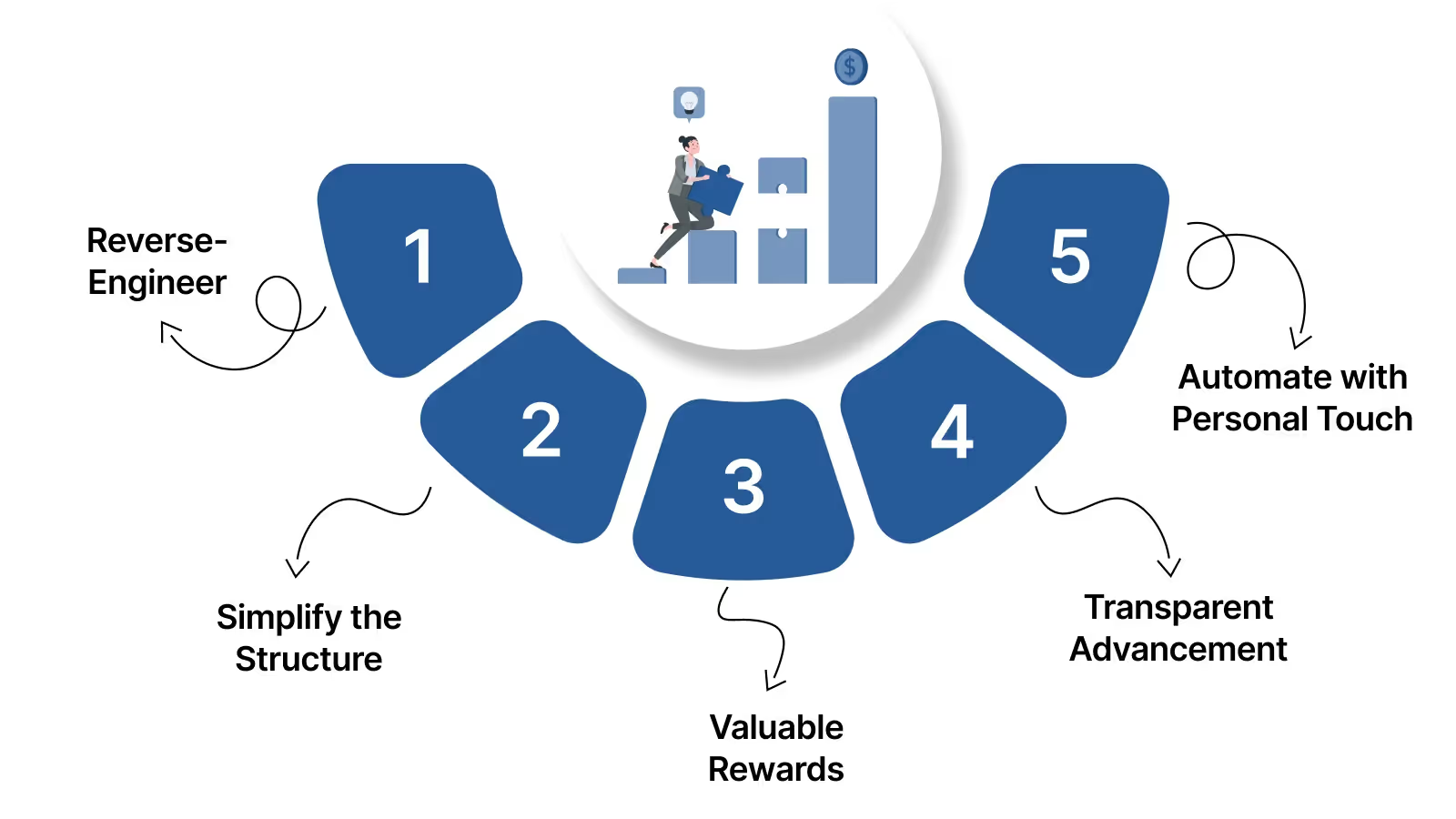
Most tiered programs sound great on paper - Bronze, Silver, Gold, maybe even Diamond if you're feeling fancy. But the reality? Many of them barely nudge customer behavior. That’s because they’re built around guesswork, not growth.
If your goal is to increase retention, boost LTV, and create loyal brand advocates, your program needs more than a few catchy names and half-hearted discounts. It needs intention. Let’s break down how to build a tiered system that performs, not just exists.
Step 1 - Reverse-Engineer From the Behaviors You Want to See
Forget points for a moment. Start by identifying the business outcomes you're aiming for.
Do you want:
- Do customers come back for a second or third purchase faster?
- Higher average order values?
- Referrals and reviews to flow in organically?
Every tier, perk, and threshold should ladder back to one of these behaviors.
Example:
If your biggest gap is repeat purchases, reward Tier 2 members with a one-time discount they can only use within 14 days of their last purchase. This subtly pulls them back while creating a time-based incentive.
Step 2 - Don’t Overcomplicate the Structure
When it comes to tiers, simplicity wins. Most high-performing programs use just three tiers:
- Tier 1 – Entry (everyone starts here)
- Tier 2 – Active (some purchase activity)
- Tier 3 – VIP (your high-value customers)
The key? Progression needs to feel realistic. You don’t want customers stuck at Tier 1 for months. Give them momentum.
Framework tip:
With a setup like this, even smaller shoppers can taste early wins, while your top buyers feel recognized and incentivized to stay loyal.
Step 3 - Make Your Perks Worth Talking About
Mediocre perks lead to mediocre results. If your customers feel like they’re getting the same experience as everyone else, your “VIP tier” doesn’t mean much.
Here’s how to build value:
Tangible rewards:
- Free shipping (yes, people still love this)
- Bonus loyalty points for higher tiers
- Exclusive discounts or bundles
Experiential rewards:
- First dibs on new product drops
- Invite-only live events or webinars
- Surprise “thank you” gifts after a milestone
Emotional rewards:
- Handwritten notes (even if auto-generated)
- Birthday treats or personalized offers
- Highlighting them in your community (UGC shoutouts, loyalty leaderboard)
Pro tip:
Stack your perks intentionally. Each tier should feel more valuable than the one before, not just “more of the same.”
Step 4 - Make Earning and Advancing Crystal Clear
Customers shouldn’t need to dig through your FAQs to understand how your program works. Visibility is everything.
Communicate tier progression at key touchpoints:
- In account dashboards (“You’re 3 purchases away from VIP status!”)
- Inside order confirmation emails (“This order unlocked Tier 2, congrats!”)
- In cart or on product pages (“Gold members get 10% off, join now”)
With platforms like Nector, tier advancements update automatically and in real time by syncing directly with your Shopify or WooCommerce store data. Your customers see exactly where they stand through progress bars in their account dashboard, order confirmation emails, and even on product pages where applicable.
Step 5 - Automate Your Tier Triggers, But Keep It Personal
Yes, you want things to scale, but don’t lose the human touch.
Use automation to:
- Unlock tiers instantly based on spend or actions
- Send personalized welcome emails when a tier is hit
- Offer time-bound rewards that nudge next steps
But also add micro-moments that make the customer feel seen:
- Celebrate milestones (“You’ve placed 5 orders, here’s something special!”)
Send random surprise gifts to your top 1% of buyers - Ask for feedback from VIPs and act on it
These gestures, combined with structure, turn your loyalty program from a gimmick into a growth channel. Nector supports real-time tier unlocking based on spend or other behaviors, combined with personalized welcome emails triggered the moment a new tier is achieved. It also allows for time-sensitive rewards and surprise “thank you” gifts sent to your top 1% of buyers, nurturing loyalty quietly but effectively.
Moreover, it integrates with over 50 popular marketing tools, so your communication remains consistent across email, SMS, and social channels without extra work.
A well-structured loyalty program sets the foundation. But if you want to drive long-term retention, it’s not just about how your program is built; it’s about how you optimize it over time.
Let’s now look at some best practices that can help you get the most value from your tiered system, without overcomplicating things.
Best Practices That Turn Passive Buyers Into Lifelong Advocates
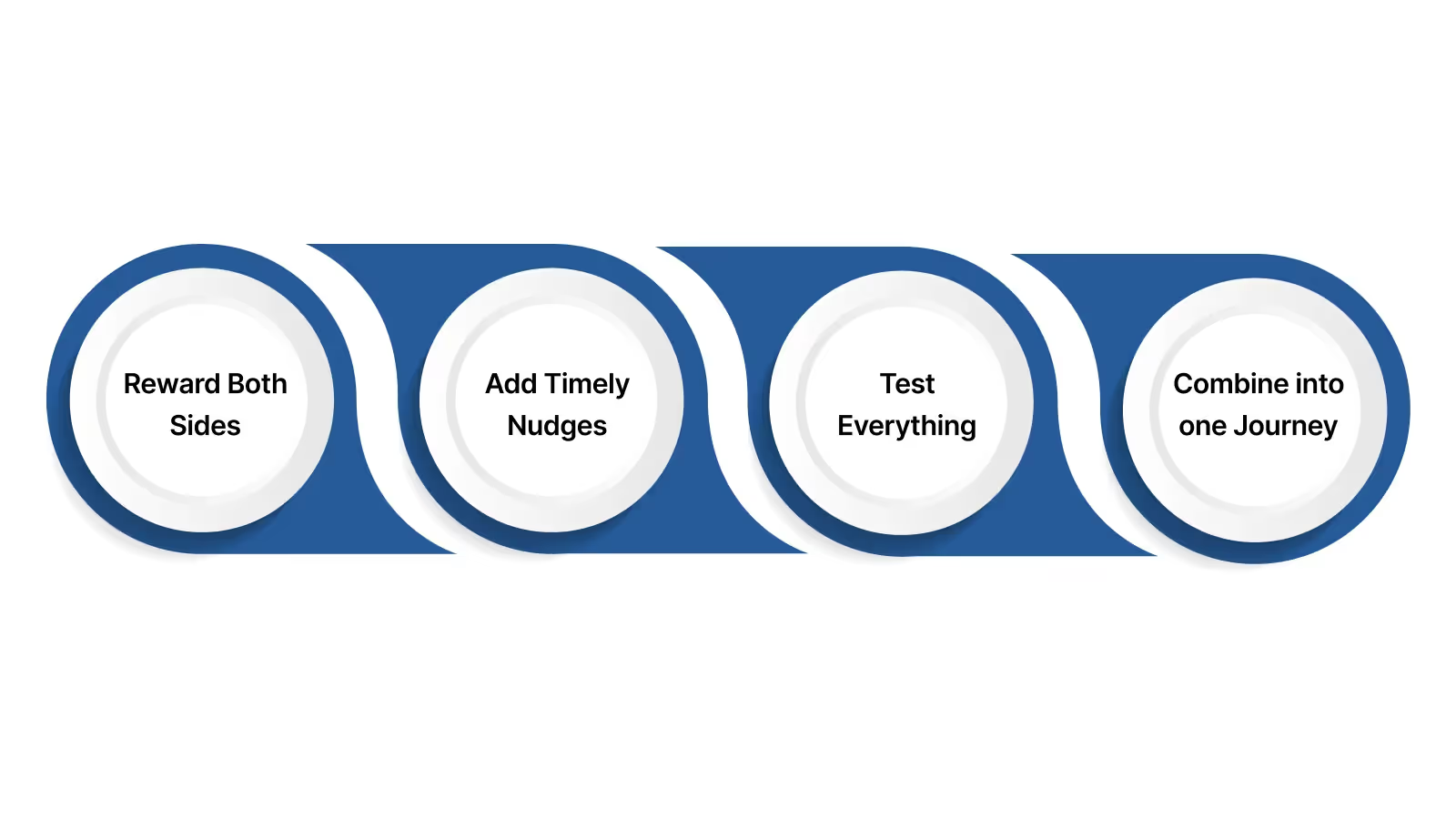
Today’s customers have more choices than ever. A great product isn’t enough. If you want them to come back, spend more, and tell their friends, your loyalty and referral program has to mean something.
That’s where these tried-and-tested strategies come in. Forget cookie-cutter perks. These are the smart moves that high-retention D2C brands are using to make their loyalty systems irresistible.
Reward Both Sides - It’s Not Just Generous, It’s Smart
Imagine this: you’re a customer who just told three friends about your favorite new skincare brand. But only your friends get the reward, not you. That doesn’t feel great, does it?
Here’s the truth:
People are far more likely to refer to others when there’s something in it for both sides. It creates a win-win dynamic; the referrer feels valued, and the new customer gets a reason to try you out. Best-in-class brands don’t just reward generosity, they reward participation.
Why it works:
- Feels personal, not transactional
- Encourages high-quality referrals (from people who want your product)
- Increases the likelihood of both first and second purchases
You’re not just giving discounts, you’re building relationships.
Add Timely Nudges, But Make Them Feel Natural
Nobody likes pressure tactics. But you can guide behavior by making opportunities feel time-sensitive, without sounding like a shouting banner ad.
Instead of:
“ACT NOW OR MISS OUT FOREVER!”
Try this:
- “Earn double points when you refer a friend before Sunday.”
- “Only 48 hours left to unlock your Gold Tier status.”
- “You’re 1 order away from a free gift. Don’t let it expire!”
Why does it feel human?
These nudges don’t scream at the user. They whisper something helpful and relevant. They offer value, not threats.
And the bonus?
You create subtle FOMO that increases engagement, but still aligns with your brand’s tone and trust.
Test Everything. Assume Nothing.
If there’s one golden rule in loyalty and referral programs, it’s this: what you think will work doesn’t matter. What your customers respond to is everything. That’s why A/B testing should be baked into your strategy, not bolted on.
Think beyond just design tweaks. Test things like:
- Messaging: “Get $10” vs. “Share the love”
- Trigger timing: Email sent 2 days vs. 5 days after purchase
- Placement: On homepage banner vs. post-checkout modal
- Incentive types: Points vs. free shipping vs. surprise gifts
Pro Tip: Start with one small variable per test. Keep the rest constant. And always measure beyond just clicks, look at repeat purchases, referral completions, and lifetime value uplift.
What happens next? You’ll start seeing your loyalty engine take shape, not a template borrowed from someone else.
Combine Reviews, Referrals, and Rewards Into One Unified Journey
Customers don’t think in silos. They don’t care if reviews live in one app, referrals in another, and loyalty points in a third. They care about seamless experiences. So, the smartest brands make it all feel like one flow.
Imagine this user journey:
- A customer gets points after their first purchase
- They leave a review and instantly earn more points
- They refer a friend and track that status on the same dashboard
- They reach a new tier, unlocking exclusive perks, all from the same place
No friction. No confusion. Just momentum.
What does this achieve?
- Fewer drop-offs
- Higher engagement across channels
- A sense of ongoing progress, which keeps customers emotionally invested
And guess what?
Nector makes this low-code and simple, especially for Shopify and WooCommerce brands. But even if you’re using something else, the principle stays the same: your program shouldn’t feel like homework.
Getting these best practices right can turn your loyalty system into a powerful engine for retention, referrals, and revenue. But even the smartest strategies can fall flat if you overlook the small things, or worse, make common mistakes that quietly sabotage the experience.
Let’s take a quick detour through the pitfalls to avoid, so you don’t fall into traps that cost you repeat business.
Mistakes That Quietly Kill Loyalty
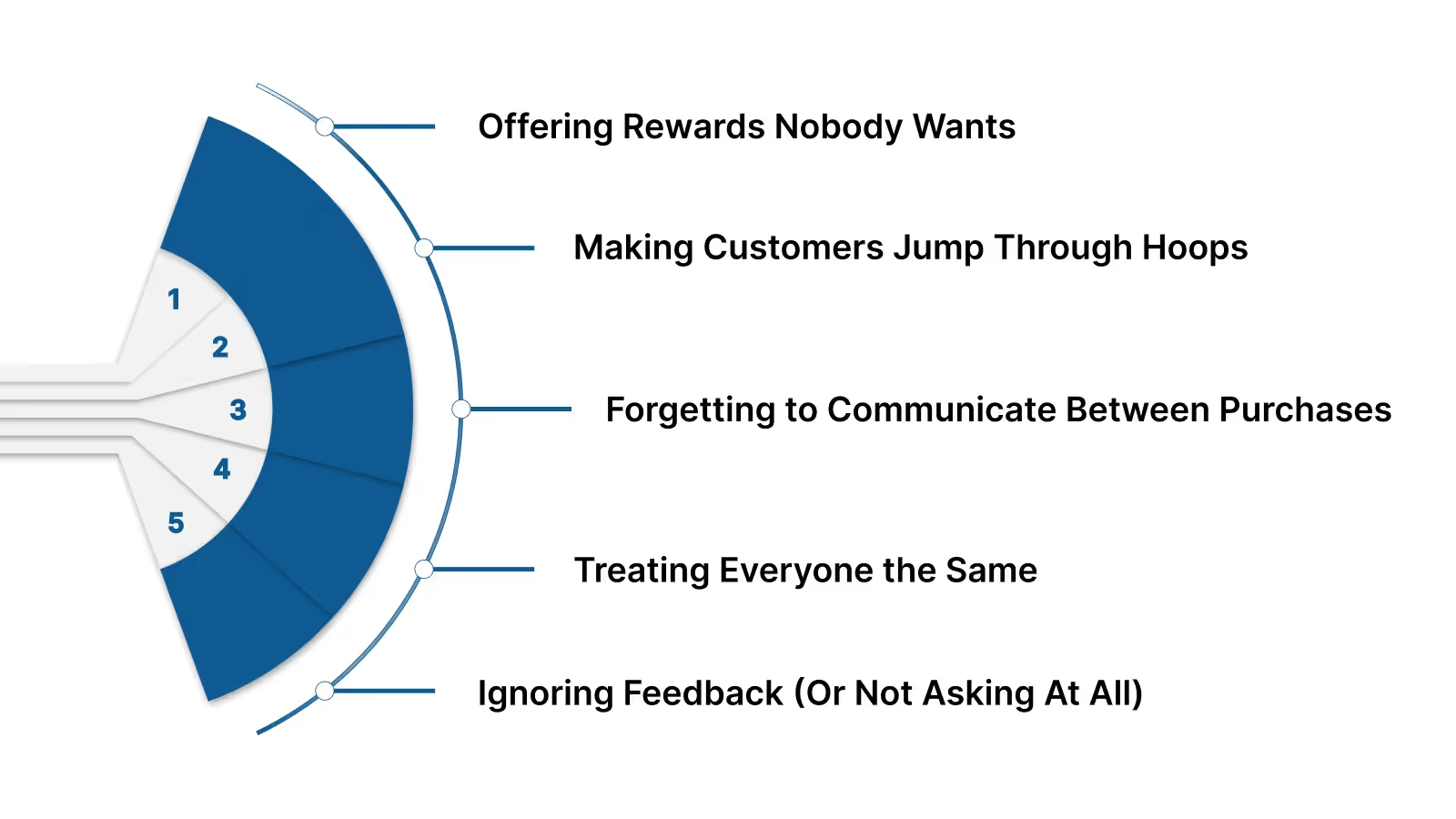
You could have the best-designed loyalty interface, the most beautiful tiers, and the most generous points system — and still wonder why your customers aren’t coming back. Why do referrals feel like a dead end? Why aren’t your retention numbers moving?
The truth? It’s often not a lack of effort. It’s just a few small mistakes that quietly break the connection between your brand and your customers. Here’s what to watch for and fix before it costs you growth.
Mistake 1 - Offering Rewards Nobody Wants
Let’s be honest, nobody’s getting excited about 100 points that unlock a branded keychain. Your rewards have to feel like a genuine perk, not leftover merch or hard-to-redeem freebies.
What to do instead:
- Tie rewards to your best sellers, not your slow movers
- Use personalized incentives based on customer behaviour (like birthday gifts, anniversary perks, or exclusive early access)
- Offer choice: let users pick between a free item, a discount, or a shipping upgrade
Think of rewards as an extension of your product experience, not a tack-on. If your product is premium, your perks should be too.
Mistake 2 - Making Customers Jump Through Hoops
If your program feels like solving a puzzle with confusing point rules, long delays, or clunky redemption, you’re losing people faster than you can onboard them.
Common turn-offs include:
- Vague point systems (“1 point per $ spent” but no clear reward tiers)
- Inaccessible dashboards or hidden referral links
- Redemption processes that require multiple steps or codes
Fix it by:
- Making the value of rewards immediately visible (“Earn 150 points and get $2.90 off”)
- Keeping all actions: referrals, points, rewards in one clean hub
- Sending regular, plain-language updates that show progress (“You’re 50 points away from your next tier!”)
A good loyalty program should feel like a conversation, not a contract.
Mistake 3 - Forgetting to Communicate Between Purchases
One of the biggest loyalty leaks? Silence. Brands that only talk to customers when it’s time to sell something lose the emotional connection that keeps people engaged.
What that looks like:
- No emails unless there’s a sale
No mention of loyalty status in post-purchase comms - Referrals are buried somewhere in the footer
The fix:
- Celebrate milestones (“You hit Silver Tier! Enjoy 2x points this month”)
- Surface share opportunities (“Your friend just placed an order, here’s $2.32 on us”)
- Use loyalty nudges in your retention flows, not just sales emails
Your loyalty system isn’t a background feature. It’s part of the customer story. So let it show up between the lines.
Mistake 4 - Treating Everyone the Same
All customers are not created equal, and they shouldn’t be treated like they are. A one-size-fits-all loyalty or referral strategy makes VIPs feel unrecognized, and new users feel overwhelmed.
The result?
- High-value buyers feel ignored.
- New customers bouncing before they understand how things work
- Power referrers never get extra love
Instead, segment and personalize:
- Offer bonus tiers or hidden perks for the top 5% spenders
- Use tier-based communication (Gold users get early drops, Bronze users get onboarding nudges)
- Track referral volume and surprise your biggest advocates with custom rewards or DMs
People want to feel like you see them. The best programs make that happen without them ever asking.
Mistake 5 - Ignoring Feedback (Or Not Asking At All)
If customers aren’t engaging with your program, the last thing you should do is guess why. The simplest way to get better? Ask.
Try this:
- Add a 10-second feedback prompt: “Was this reward worth it?”
- Use post-redemption surveys to learn what felt smooth vs. clunky
- Regularly review common support tickets or loyalty-related complaints
Why it matters:
You’ll learn faster what to tweak, what to double down on, and what you may have overlooked entirely. Feedback closes the loop between what you think customers want and what they value.
Avoiding these common missteps can mean the difference between a loyalty program that collects dust and one that becomes a living, breathing part of your brand experience. But what if you're just starting, or ready to rebuild from scratch? Don’t worry. You don’t need a full-blown tech team or six months of planning.
In the next section, let’s break down the key elements of a high-retention loyalty setup and how you can start building smarter from day one.
Also read: The Psychology and Benefits of Rewards Programs: Boost Customer Loyalty & Business Growth.
How to Measure the ROI of VIP Loyalty Programs
It’s easy to get caught up in the excitement of launching a VIP loyalty program, the tiers, the perks, the branding. But once it’s live, the real question is: Is it moving the needle?
If you’re not tracking ROI, you’re flying blind. The good news? Measuring the performance of a VIP program doesn’t have to be complicated, especially if you focus on a few core metrics that reflect customer engagement, retention, and revenue growth.
The Metrics That Matter
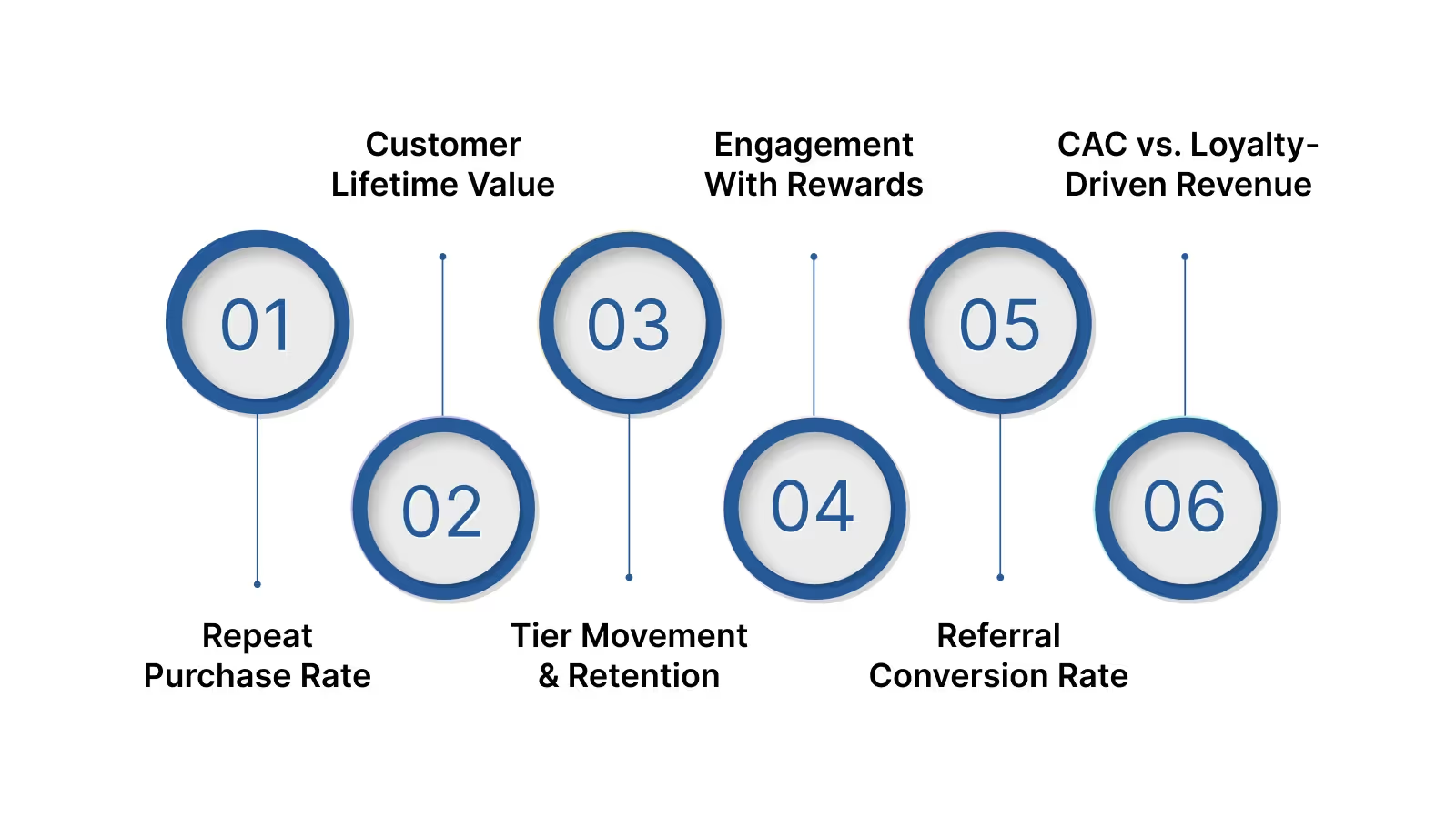
Not every data point deserves your attention. Here are the ones that will give you the clearest picture of your program’s ROI:
1. Repeat Purchase Rate (RPR)
This is your north star. If your VIP tiers are working, this number should go up, especially in the mid-to-top tiers.
Formula: Repeat Customers ÷ Total Customers
2. Customer Lifetime Value (LTV)
The longer your customers stay active and spend, the more profitable your business becomes. Loyalty tiers should gradually lift LTV as customers aim for higher rewards.
Pro Tip: Track LTV per tier. It’ll reveal which level delivers the highest ROI and where you may need to tweak incentives.
3. Tier Movement & Retention
How many customers are moving up tiers each quarter? How many drop off? Tier velocity and tier retention give you insight into whether your program is both engaging and sustainable.
4. Engagement With Rewards
It’s not enough to offer perks; customers need actually to use them. Monitor redemption rates for each reward, particularly in your top tiers. A perk that no one clicks is just a wasted budget.
5. Referral Conversion Rate
Are your VIP members referring to others? This is often an underrated benefit of higher tiers; members are more likely to become advocates, especially when referral bonuses are built in.
Track: Referrals generated per tier + conversion rates of referred customers.
6. CAC vs. Loyalty-Driven Revenue
When done right, loyalty tiers offset CAC by generating high-value, self-sustaining revenue from existing customers. Compare acquisition spend with revenue generated from top-tier members. This contrast makes ROI very tangible.
Use Dashboards to Spot Trends Early
If you’re using a loyalty platform, make sure it offers custom dashboards that let you segment users by tier and behavior. This real-time visibility lets you act fast, whether it’s tweaking a reward, adjusting tier thresholds, or launching a seasonal bonus.
Before we close, remember: ROI isn’t just a number, it’s the confidence that your loyalty program is creating deeper, longer-lasting customer relationships. And when measured consistently, it becomes your proof of growth.
Let’s now talk about what it takes to launch a VIP program without breaking your back (or budget).
Getting Started Easily: Launch Your VIP Program
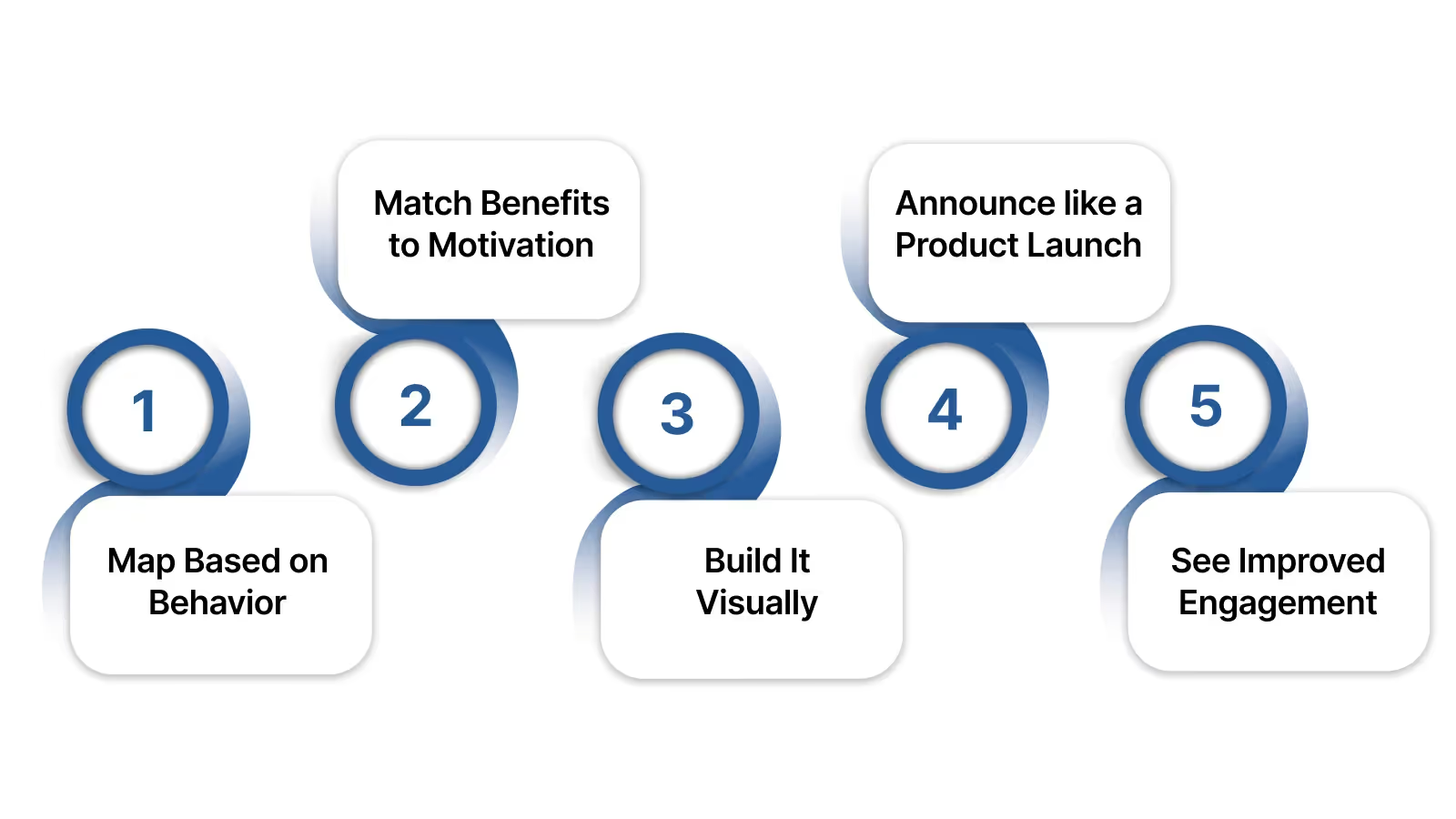
Here’s the truth: most brands overcomplicate loyalty. They think VIP programs need six months of dev time, massive budgets, and a dedicated loyalty manager. But that’s just not true anymore.
Today, you can launch a tiered loyalty experience in days, not weeks, without coding, without spreadsheets, and without drowning in logistics.
And no, it doesn’t have to be a bare-minimum setup either. The best platforms now offer fully branded, deeply customizable VIP systems that feel like they were built in-house but weren’t. If you’ve never run a loyalty program before (or even if you have), here’s a fast-track roadmap:
Step 1: Map Your Tiers Based on Real Behavior
Don’t guess, look at your data. How often do your top 20% of customers shop? What's their average spend? Use this to define your tier triggers. For example:
- Tier 1: Spends $20+
- Tier 2: Spends $70+
- Tier 3: Spends $150+
Keep it simple at first. You can always expand later once you know what resonates.
Step 2: Match Benefits to Motivation
Rewards only work if they match what your audience values. Discounts are fine, but exclusive access, early drops, surprise gifts, and priority support often feel more personal, nd cost you less in margin.
Think: “How can we make this feel like a club they want to stay in?”
Step 3: Build It Visually - No Devs Needed
Platforms like Nector let you design and launch tiered systems without writing a line of code. From reward rules to tier upgrades and even automated emails, it’s all built to be DIY, but still polished.
You can also track movement across tiers, trigger retention nudges, or auto-demote inactive users. Everything happens behind the scenes, but it feels seamless to your customer.
Step 4: Announce Like It’s a Product Launch
This is key. Don’t just add a new tab in your navigation and hope people find it. Build buzz.
- Send an email: “You’ve just unlocked VIP status.”
- Add banners on your homepage.
- Use a pop-up for logged-in users: “Only $10 away from Gold Tier, unlock your next reward!”
You worked hard to build this, make sure people actually see it, and more importantly, feel it.
Step 5: Watch the Engagement Roll In
Once your VIP program is live, the real magic happens. You’ll start to notice:
- More repeat purchases (especially around tier upgrade moments)
- Higher average order values
- Better retention after the second and third purchase
- An uptick in referrals and UGC from your top-tier customers
And all of that? Directly impacts your bottom line, without spending more on ads. If you're interested in a system that integrates your store data effortlessly and lets you customize your loyalty tiers visually without coding, exploring platforms like Nector can be worthwhile.
Also read: 9 Successful Loyalty Program Examples of 2025

Final Thoughts
VIP tier programs aren’t just about giving more to your top customers; they’re about building a system that rewards loyalty, drives predictable revenue, and makes your brand harder to walk away from. When thoughtfully designed, these programs do more than increase retention. They deepen emotional connection, surface high-value customers faster, and turn every repeat purchase into a compounding growth loop.
In a world where acquisition costs are rising and customer expectations are shifting, tiered programs offer more than perks; they deliver structure, purpose, and performance. The brands winning today are the ones building loyalty into the foundation of their customer experience, not treating it as an add-on.
But launching a tiered strategy doesn’t have to be a heavy lift. With the right tools, data, and structure, it’s entirely possible to get started without friction and start seeing results faster than you'd expect.
Ready to turn one-time buyers into lifelong loyalists?
Build tiered loyalty programs that reward what matters, keep customers coming back, and drive measurable ROI. All without reinventing your stack.
Book a demo with Nector.io and see how easily you can turn loyalty into long-term growth.
FAQs
What is a VIP tier program, and how is it different from a regular loyalty program?
It’s a loyalty model with levels like Silver, Gold, or Platinum. Unlike basic point systems, VIP tiers create exclusivity and reward customers based on spend or engagement.
How many tiers should I start with?
Three tiers are a great starting point:
- Tier 1 (Entry): Available to all new customers
- Tier 2 (Engaged): Unlocked after a set spend or number of orders
- Tier 3 (VIP): Reserved for your most loyal customers
This structure balances ease of entry with aspirational goals, creating momentum for continued engagement.
What types of rewards work best in VIP programs?
The best-performing VIP programs combine three reward types:
- Tangible: Free shipping, bonus points, early access
- Experiential: Surprise product drops, private events, beta access
- Emotional: Birthday rewards, handwritten notes, shoutouts on socials
The magic lies in the experience, not just the reward. Each tier should feel like a meaningful upgrade.
How do I measure success for my VIP program?
Track these four core metrics:
- Repeat purchase rate
- Reward redemption rate
- Tier progression velocity (how quickly users move up)
- LTV per tier
Together, these indicators show if your program is driving higher engagement, stronger retention, and deeper spend across customer segments.
Do I need developers to build a VIP tier program?
No. With no-code tools like Nector, you can launch and manage VIP tiers on platforms like Shopify or WooCommerce, no dev team needed.
Start Building Customer Retention That Lasts




